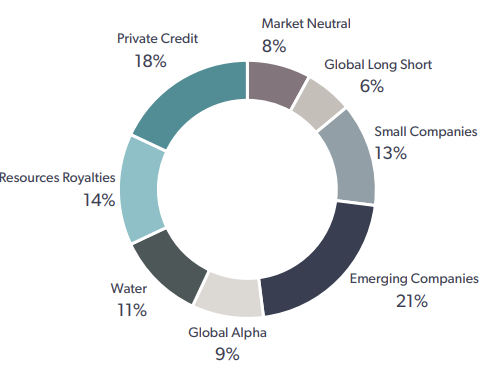Regal Investment Fund
Exposure to a range of alternative investment strategies
The investment philosophy of RF1 is grounded in the belief that a diversified portfolio of assets, using a range of investment strategies backed by long-term capital, is key to the potential of achieving greater risk adjusted returns over the long term.
In order to achieve its objective, RF1 will provide investors with exposure to a range of investment strategies managed by Regal, where strategy allocations are adjusted over time depending on prevailing market conditions.
Regal Investment Fund allocation as at 31 October 2025
As at 31 October 2025. The RF1 portfolio will be constructed using multiple Regal Partners. Investment Strategies and these strategies are not necessarily limited to the current Investment Strategies.
Investing with Regal
The Regal Investment Fund provides investors with exposure to Regal's investment expertise, including our 20-year long track record of managing alternative investment strategies. The investment team members have, on average, over ten years' experience in financial markets both in Australia and overseas, with extensive experience of investing through many market cycles. The team has experience on the buy and sell side, fundamental investing, sales and research, long-side and hedge fund investing as well as investment banking and capital markets.
VIEW TEAM
Risk
The Fund may appeal to investors who are seeking risk-adjusted absolute returns from alternative investment strategies to diversify their investment portfolio. Investors should regard any investment in the Fund as a long-term proposition and are to be aware that substantial fluctuations in the value of the portfolio held by the Fund may occur on a month-to-month basis over that period. A detailed explanation of risks is available in the Product Disclosure Statement.
Documents
News and Insights

Learn more about RF1 and alternative investments

What is RF1? - Interview between David Wright, Zenith Investment Partners and Phil King, Regal

How to use RF1 in portfolios - David Wright, Zenith Investment Partners

Alternative Investments: What, how and why? Used with permission. Regal did not pay for this video.
Frequently asked questions
Contact Us
If you are a securityholder and require assistance, please contact 1800 221 227 (within Australia)
8:30am to 5:30pm Monday to Friday (Sydney time) or email regalfund@cm.mpms.mufg.com
You have the right to elect whether to receive some or all of these Communications in electronic or physical form and the right to elect not to receive annual financial reports at all. You also have the right to elect to receive a single specified Communication on an ad hoc basis, in an electronic or physical form.






